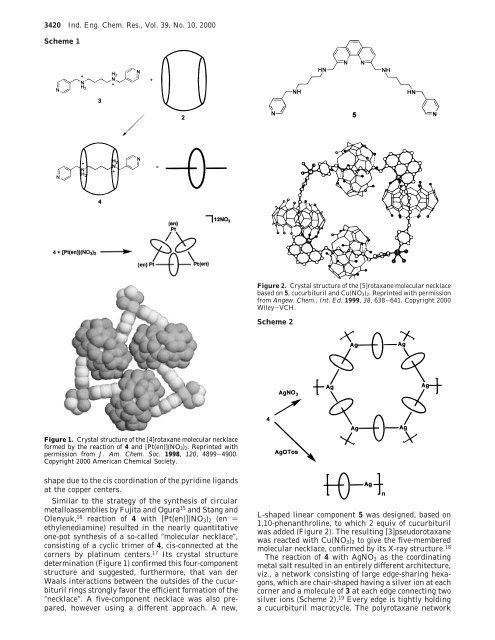Self-assembled Architectures from Glycoluril - Cluster for Molecular ...
Self-assembled Architectures from Glycoluril - Cluster for Molecular ...
Self-assembled Architectures from Glycoluril - Cluster for Molecular ...
You also want an ePaper? Increase the reach of your titles
YUMPU automatically turns print PDFs into web optimized ePapers that Google loves.
3420 Ind. Eng. Chem. Res., Vol. 39, No. 10, 2000<br />
Scheme 1<br />
Figure 1. Crystal structure of the [4]rotaxane molecular necklace<br />
<strong>for</strong>med by the reaction of 4 and [Pt(en)](NO3)2. Reprinted with<br />
permission <strong>from</strong> J. Am. Chem. Soc. 1998, 120, 4899-4900.<br />
Copyright 2000 American Chemical Society.<br />
shape due to the cis coordination of the pyridine ligands<br />
at the copper centers.<br />
Similar to the strategy of the synthesis of circular<br />
metalloassemblies by Fujita and Ogura15 and Stang and<br />
Olenyuk, 16 reaction of 4 with [Pt(en)](NO3)2 (en )<br />
ethylenediamine) resulted in the nearly quantitative<br />
one-pot synthesis of a so-called “molecular necklace”,<br />
consisting of a cyclic trimer of 4, cis-connected at the<br />
corners by platinum centers. 17 Its crystal structure<br />
determination (Figure 1) confirmed this four-component<br />
structure and suggested, furthermore, that van der<br />
Waals interactions between the outsides of the cucurbituril<br />
rings strongly favor the efficient <strong>for</strong>mation of the<br />
“necklace”. A five-component necklace was also prepared,<br />
however using a different approach. A new,<br />
Figure 2. Crystal structure of the [5]rotaxane molecular necklace<br />
based on 5, cucurbituril and Cu(NO3)2. Reprinted with permission<br />
<strong>from</strong> Angew. Chem., Int. Ed. 1999, 38, 638-641. Copyright 2000<br />
Wiley-VCH.<br />
Scheme 2<br />
L-shaped linear component 5 was designed, based on<br />
1,10-phenanthroline, to which 2 equiv of cucurbituril<br />
was added (Figure 2). The resulting [3]pseudorotaxane<br />
was reacted with Cu(NO3)2 to give the five-membered<br />
molecular necklace, confirmed by its X-ray structure. 18<br />
The reaction of 4 with AgNO3 as the coordinating<br />
metal salt resulted in an entirely different architecture,<br />
viz., a network consisting of large edge-sharing hexagons,<br />
which are chair-shaped having a silver ion at each<br />
corner and a molecule of 3 at each edge connecting two<br />
silver ions (Scheme 2). 19 Every edge is tightly holding<br />
a cucurbituril macrocycle. The polyrotaxane network

















